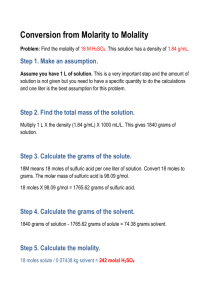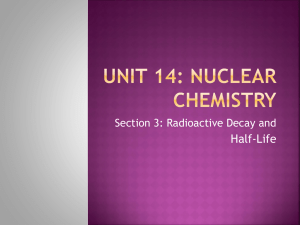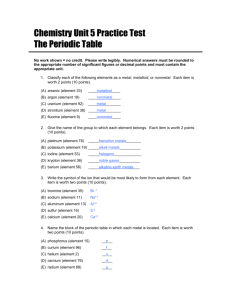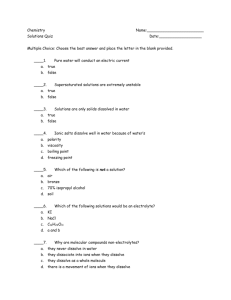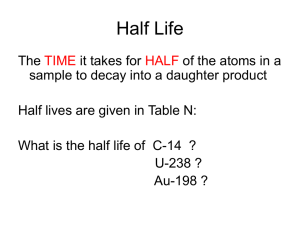The Chemistry Reference tables are undoubtedly your most
advertisement
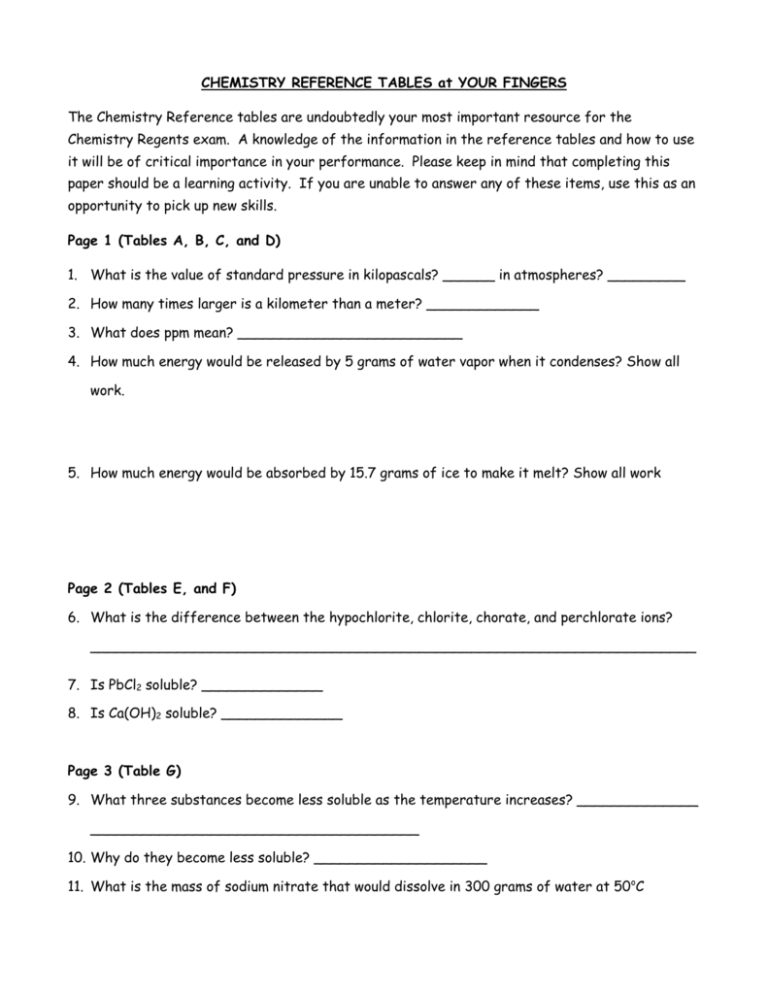
CHEMISTRY REFERENCE TABLES at YOUR FINGERS The Chemistry Reference tables are undoubtedly your most important resource for the Chemistry Regents exam. A knowledge of the information in the reference tables and how to use it will be of critical importance in your performance. Please keep in mind that completing this paper should be a learning activity. If you are unable to answer any of these items, use this as an opportunity to pick up new skills. Page 1 (Tables A, B, C, and D) 1. What is the value of standard pressure in kilopascals? ______ in atmospheres? _________ 2. How many times larger is a kilometer than a meter? _____________ 3. What does ppm mean? __________________________ 4. How much energy would be released by 5 grams of water vapor when it condenses? Show all work. 5. How much energy would be absorbed by 15.7 grams of ice to make it melt? Show all work Page 2 (Tables E, and F) 6. What is the difference between the hypochlorite, chlorite, chorate, and perchlorate ions? ______________________________________________________________________ 7. Is PbCl2 soluble? ______________ 8. Is Ca(OH)2 soluble? ______________ Page 3 (Table G) 9. What three substances become less soluble as the temperature increases? ______________ ______________________________________ 10. Why do they become less soluble? ____________________ 11. What is the mass of sodium nitrate that would dissolve in 300 grams of water at 50oC Page 4 (Table H) 12. What is the vapor pressure of ethanol at standard temperature? _____________________ 13. What would the temperature have to be if the vapor pressure of water was 100kPa? ______________ 14. Which substance has the highest boiling point at standard pressure? __________________ Why? ___________ Page 5 (Tables I, and J) 15. How many combustion reactions are listed on table I? ______________________________ 16. Is the following reaction endo or exothermic: C(s) + O2(g) 17. Is the following reaction spontaneous? 2Li+ + Ca CO2(g) __________________ 2Li + Ca2+ ____________________ Page 6 (Tables K, L, M, and N) 18. What is the molecular formula of phosphoric acid? _________________________ 19. What is the name for the following molecule NaOH? ________________________ 20. According to your answer to question 19, what ions would be produced when the molecule is placed in water? __________________________ 21. Will the pH be greater than, less than, or equal (circle one)to 7? 22. If methyl orange is added to a solution with a pH of 3, what color will the methyl orange be? _______________________ 23. If a rock is found to be 4.5 X 109 years old, how many half lives of uranium – 238 have occurred? ________________________ 24. How many radioactive elements experience: a. Beta decay? ___________ b. Alpha decay? ___________ c. Positron decay? _________ Pages 7 & 8 (Tables O, P, Q, and R) 25. What is particle X in the following equation: 235 U X+ 231 Th 26. What type of radiation does this represent? ____________________ 27. How many carbons are present in decane? ______________________ 28. Draw the structural formula for ethyne in the space below 29. Write the condensed structural formula for the following organic compounds: Ethanol dimethyl ether 3 hexanone ethanoic acid ethanal methyl ethanoate butanamide Page 9 (Periodic Table) 30. Which period 2 element has the most oxidation states? _________________ 31. How many protons are present in one atom of argon? _________________ 32. Hydrogen has 3 different isotopes 1H, 2H, and 3H. Which of these isotopes is the most abundant? __________ 33. How does the atomic mass for hydrogen show this? _______________________________ ______________________________________________________________________ 34. How are the isotopes of hydrogen different from each other? _______________________ ______________________________________________________________________ 35. If cesium loses an electron, it will have the same electron configuration as which noble gas? ___________________ 36. What is the name for the following groups? a. Group 1: _____________________________ b. Group 2: _____________________________ c. Group 17: ____________________________ d. Group 18: ____________________________ 37. What are the group numbers of the transition metals? _____________________________ 38. How many valence electrons does each of the following groups have? a. Group 1: __________ e. Group 15: __________ b. Group 2: __________ f. Group 16: __________ c. Group 13: __________ g. Group 17: __________ d. Group 14: __________ h. Group 18: __________ Pages 10 & 11 (Table S) 39. What happens to the electronegativity as you go down group 17? _____________________ 40. What causes this to happen? ________________________________________________ 41. What happens to the electronegativity as you go left to right for period 2? _____________ 42. What causes this to happen? ________________________________________________ 43. What happens to the first ionization energy as you go down group 17? _________________ 44. What causes this to happen? ________________________________________________ 45. What happens to the first ionization energy as you go left to right for period 2? __________ 46. What causes this to happen? ________________________________________________ 47. What is the relationship between electronegativity and first ionization energy? __________ ______________________________________________________________________ 48. Why does mercury exist as a liquid at STP? _____________________________________ 49. What happens to the atomic radius as you go from left to right in period 3? _____________ 50. What causes this to happen? ________________________________________________ 51. As you go down group 16, what happens to the atomic radius? ________________________ 52. Why does this happen? ____________________________________________________ 53. Would oxygen exist as a solid, liquid, or gas at –32oC? _____________________________ Page 12 (Table T) 54. What is the mass of a 34cm3 sample of lead (note: see table S for its density). Show all work 55. How many grams of oxygen are present in a 3.2 mol sample of O2? 56. A student measures the density of iron to be 8 g/cm3. What is the student’s percent error? (hint: find the density on table S). 57. What is the percent composition of oxygen in a sulfate ion? (hint: find the formula for sulfate ion on table E). 58. How many moles of sulfuric acid are in 2.70 liters of a 3.0 M solution? 59. What volume will a 300.0 mL sample of a gas at STP occupy when the pressure is doubled at constant temperature? 60. To neutralize 1 M sulfuric acid, a 2 M concentration of sodium hydroxide is required. How many liters of sodium hydroxide must be used to completely neutralize 1 L of the sulfuric acid?


